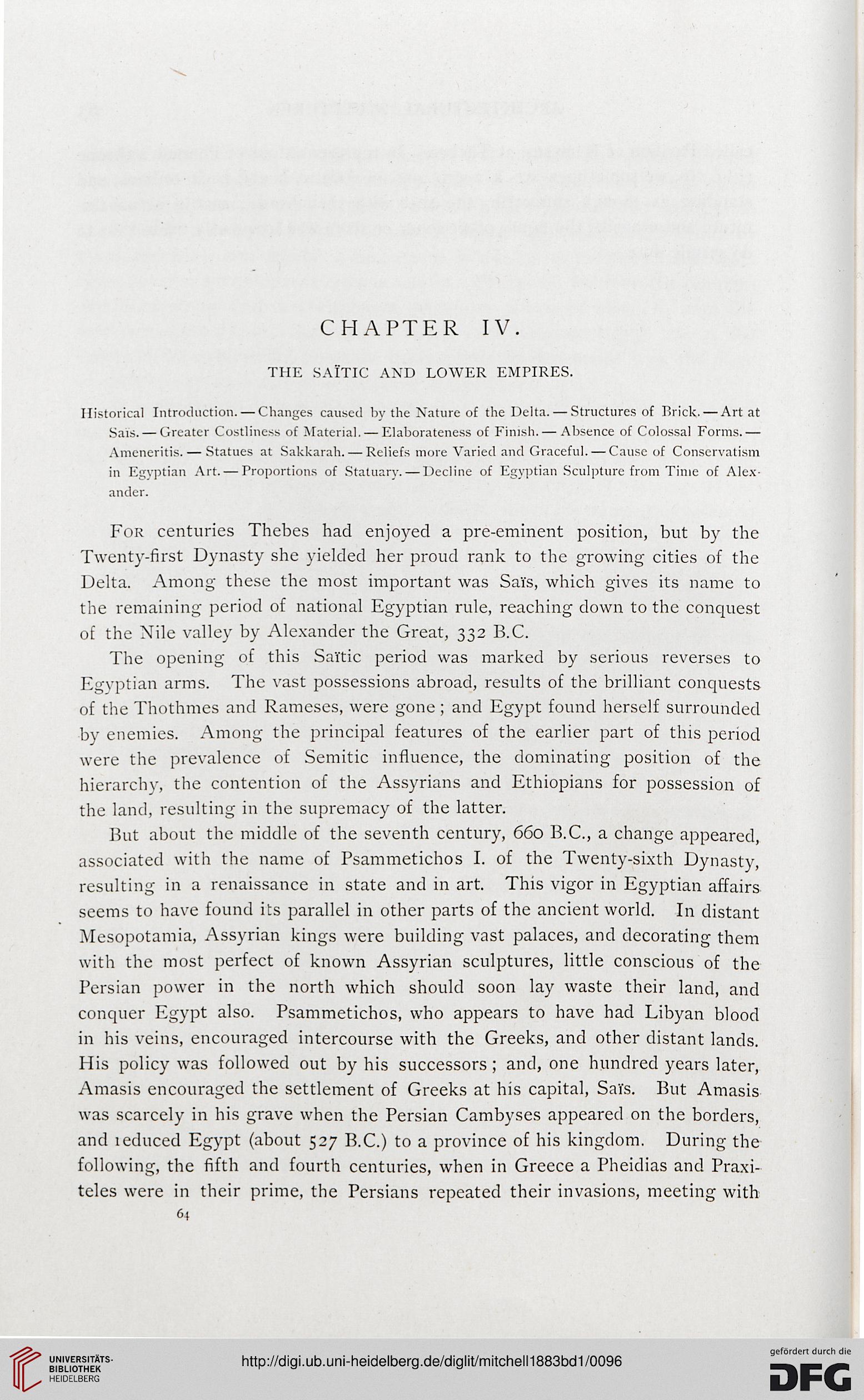CHAPTER IV.
THE SAlTIC AND LOWER EMPIRES.
Historical Introduction. — Changes caused bv the Nature of the Delta. — Structures of Brick. — Art at
Sais. — Greater Costliness of Material. — Elaborateness of Finish. — Absence of Colossal Forms.—
Ameneritis. — Statues at Sakkarah. — Reliefs more Varied and Graceful. — Cause of Conservatism
in Egyptian Art. — Proportions of Statuary. — Decline of Egyptian Sculpture from Time of Alex-
ander.
For centuries Thebes had enjoyed a pre-eminent position, but by the
Twenty-first Dynasty she yielded her proud rank to the growing cities of the
Delta. Among these the most important was Sai's, which gives its name to
the remaining period of national Egyptian rule, reaching down to the conquest
of the Nile valley by Alexander the Great, 332 B.C.
The opening of this Sai'tic period was marked by serious reverses to
Egyptian arms. The vast possessions abroad, results of the brilliant conquests
of the Thothmes and Rameses, were gone; and Egypt found herself surrounded
by enemies. Among the principal features of the earlier part of this period
were the prevalence of Semitic influence, the dominating position of the
hierarchy, the contention of the Assyrians and Ethiopians for possession of
the land, resulting in the supremacy of the latter.
But about the middle of the seventh century, 660 B.C., a change appeared,
associated with the name of Psammetichos I. of the Twenty-sixth Dynasty,
resulting in a renaissance in state and in art. This vigor in Egyptian affairs
seems to have found its parallel in other parts of the ancient world. In distant
Mesopotamia, Assyrian kings were building vast palaces, and decorating them
with the most perfect of known Assyrian sculptures, little conscious of the
Persian power in the north which should soon lay waste their land, and
conquer Egypt also. Psammetichos, who appears to have had Libyan blood
in his veins, encouraged intercourse with the Greeks, and other distant lands.
His policy was followed out by his successors ; and, one hundred years later,
Amasis encouraged the settlement of Greeks at his capital, Sa'is. But Amasis
was scarcely in his grave when the Persian Cambyses appeared on the borders,
and teduced Egypt (about 527 B.C.) to a province of his kingdom. During the
following, the fifth and fourth centuries, when in Greece a Pheidias and Praxi-
teles were in their prime, the Persians repeated their invasions, meeting with
THE SAlTIC AND LOWER EMPIRES.
Historical Introduction. — Changes caused bv the Nature of the Delta. — Structures of Brick. — Art at
Sais. — Greater Costliness of Material. — Elaborateness of Finish. — Absence of Colossal Forms.—
Ameneritis. — Statues at Sakkarah. — Reliefs more Varied and Graceful. — Cause of Conservatism
in Egyptian Art. — Proportions of Statuary. — Decline of Egyptian Sculpture from Time of Alex-
ander.
For centuries Thebes had enjoyed a pre-eminent position, but by the
Twenty-first Dynasty she yielded her proud rank to the growing cities of the
Delta. Among these the most important was Sai's, which gives its name to
the remaining period of national Egyptian rule, reaching down to the conquest
of the Nile valley by Alexander the Great, 332 B.C.
The opening of this Sai'tic period was marked by serious reverses to
Egyptian arms. The vast possessions abroad, results of the brilliant conquests
of the Thothmes and Rameses, were gone; and Egypt found herself surrounded
by enemies. Among the principal features of the earlier part of this period
were the prevalence of Semitic influence, the dominating position of the
hierarchy, the contention of the Assyrians and Ethiopians for possession of
the land, resulting in the supremacy of the latter.
But about the middle of the seventh century, 660 B.C., a change appeared,
associated with the name of Psammetichos I. of the Twenty-sixth Dynasty,
resulting in a renaissance in state and in art. This vigor in Egyptian affairs
seems to have found its parallel in other parts of the ancient world. In distant
Mesopotamia, Assyrian kings were building vast palaces, and decorating them
with the most perfect of known Assyrian sculptures, little conscious of the
Persian power in the north which should soon lay waste their land, and
conquer Egypt also. Psammetichos, who appears to have had Libyan blood
in his veins, encouraged intercourse with the Greeks, and other distant lands.
His policy was followed out by his successors ; and, one hundred years later,
Amasis encouraged the settlement of Greeks at his capital, Sa'is. But Amasis
was scarcely in his grave when the Persian Cambyses appeared on the borders,
and teduced Egypt (about 527 B.C.) to a province of his kingdom. During the
following, the fifth and fourth centuries, when in Greece a Pheidias and Praxi-
teles were in their prime, the Persians repeated their invasions, meeting with




